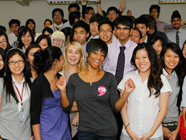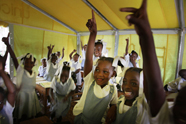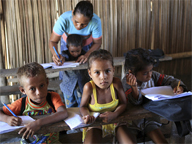
Monique Coleman was appointed the first UN Youth Champion for the International Year of Youth, kicked off in August 2010 and culminating in the High-level Meeting on Youth on 25-26 July. Touring the world, she has strived to ensure that young people’s initiatives are not neglected or overlooked. “The most important thing to me is to put actions to our words,” says Monique in an interview for DESA News.
Tell us about what you have done and plan to do in the future as the UN Youth Champion and beyond
”The GimmeMo Tour is the biggest initiative I’ve made for the International Year of Youth. At the end of January, I set out to tour for six months around the world. I’ve been going to each continent and all different regions from developing countries to developed countries to really try to raise awareness about the International Year of Youth, the issues that young people face and to highlight and bring attention to the wonderful organizations that are making a difference in their respective communities.
The other thing I’ve been trying is to share this information, what I experience and what I see by imploring social media technology, by using my Facebook page, as well as the Year of Youth Facebook page and Twitter. I have a website that’s completely devoted to empowering young people. Another aspect is speaking to high-level government officials and to be a bridge between the young people I am representing and their respective governments.”
What do you see as some of the biggest problems the youth of today face?
“It varies from place to place, the biggest issue I think is that in developing countries and in developed countries there are totally different issues. I think one thing that is difficult is when you’re dealing sometimes with developing countries that have shaky governments. I think the big issue is when young people don’t have access to help and resources.
One of the concerns that the people I’ve met with have is feeling that their messages don’t make it all the way to the UN, or the government or a high level position where policy actually comes into play. That’s essentially what I think one of the roles of the youth champion is: to bridge that gap between the UN, government and the people.”
For the high-level meeting in July, the General Assembly will discuss many of the issues the youth faces. How do you think we can bridge the age gap and get the UN, governments etc to listen to the youth?
“We have to remember who the audience is and there are tangible ways to engage young people. At that meeting specifically, I think it is important to give young people a platform to actually speak. I’ve met so many incredible youth that are leaders of youth organizations and have such high level positions in their respective countries and I think hearing young people at a conference specially devoted to them is essential.“
From your experiences on tour, what do you think some of the biggest issues that need to be discussed at the General Assembly meeting?
One thing that really needs to be discussed is the situation with young people on the streets. Unemployment as a whole is an issue that needs to be addressed, but not just in the idea of unemployment, but vulnerable employment and the fact that many young people have to take jobs because they have no choice. They are not privileged enough to be unemployed because they can’t find time off to find decent work. I think work should be a big point on the agenda as well as participation, girls and the rights of girls and girls being able to advance in their communities.
What can governments and member states do to bridge these gaps and fix these problems?
“What I’m trying to do is really reach a person on an individual level and really empower people not to wait for someone else to make a decision and not to wait for a policy to be put in place before they start taking actions themselves. I think it is very important for governments and members of state to support community activities and to support the activities that people are doing, but I think it is our job to actually initiate them, especially young people.”
What have you done so far on tour and off to help fix these problems?
“The main thing I’ve been doing has been initiating conversation. The theme of the year is very buoyant, which is ‘Dialogue and Mutual Understanding.’ I think everything starts at the conversation level, just having a dialogue about it. I’ve had the ability to do events at the US Embassy in India and Indonesia. We did a web chat and implored social technology to stream it live. The dialogue and conversation that comes out of it is really interesting and usually in that situation young people can figure out who their allies are.
I’ve also been volunteering, putting action to the things that are already happening instead of trying to come in and invent something new. When I go to a place, I ask them what are the issues, its varied from here, we deal with trafficking and girls being swooned into prostitution, here we’re dealing with clean drinking water and here we’re dealing with sanitation.”
Working with the International Year of Youth and your GimmeMo Tour targeting the youth, you need to take a different strategy. How have you approached this? Do you find this effective?
“The main thing I’ve been doing is treating young people like people. And not like they are going to arrive somewhere, but that they are already there to give them ideas of things they can do today. I think a lot of the times people approach young people as if they don’t care. I approach young people as if they all care, and are excited ready, willing and anxious to make a difference and give them the benefit of the doubt that if presented with an opportunity to be great, they would take it.
And another major strategy is to put myself out there. I’m candid, very honest and very open about my own life, my own struggles, my own insecurities, the challenges that I face, and my triumphs. I definitely wear my heart on my sleeve and am not afraid to be honest about anything. If it was a strategy, that‘s my main tactic, sheer authenticity.”
What are some of the biggest strives you think the youth, yourself and governments have made?
“Well, I think two places that really stand out, and they’re both developed, are Australia and Greece. Their governments have really put people in positions to make change specifically for the youth. In Australia, the Minister for School Education, Early Childhood and Youth is Peter Garrett, a former rock and roller activist turned politician. It’s such a perfect fit because his passion that he sang about, has now put him in a place where he can do something about it. In Greece, I’ve spent time in Thessalonki and they are a candidate for the European Youth Capital in 2014, so a lot of initiative is happening in their government. They have created very high-level positions specifically in the direction of youth.
The youth and the organizations they have created are endless. You can’t talk about the power of the youth without mentioning the power that youth have when they come together for change. I think we’re all watching some of the biggest strides you could have made in front of our eyes presently.
As for me, I’m just a girl, suitcase, hotel, just really trying to let other people know they can do anything and that change is in their horizon if you keep moving forward. I think the only way to really make a difference or do anything is to actually put yourself out there. You can do this, you can do anything. If you’re a nurse in a small town but you have a specific passion or there are children from Africa that can benefit from your knowledge, you can explain all the things that you want to do. I’m hoping to simply just inspiring by being me.”
For more information:
International Year of Youth: http://social.un.org/youthyear/
Monique Coleman: http://www.gimmemo.com/


